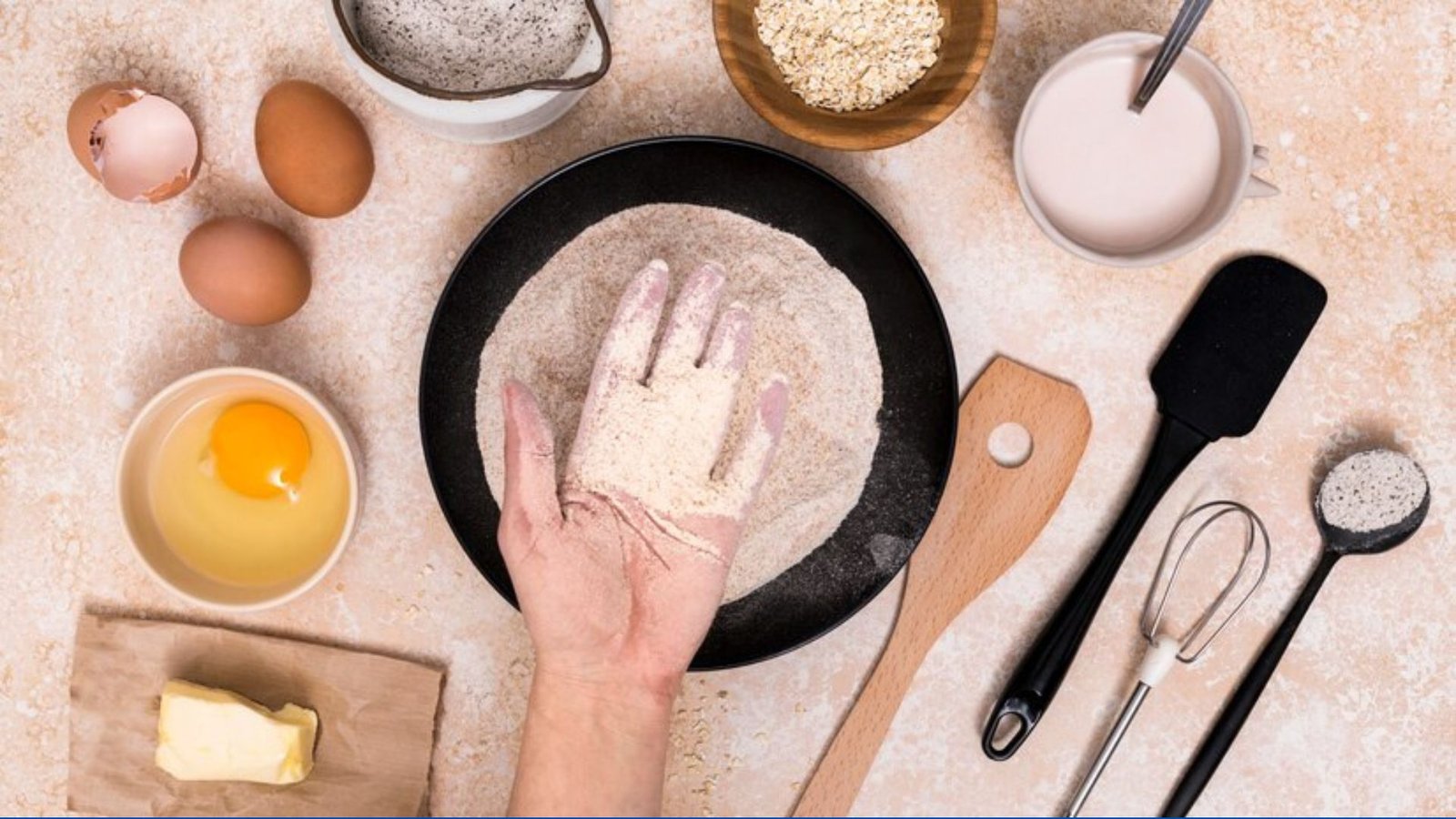Baking without gluten can be intimidating, but with the right ingredients, it can also be incredibly rewarding. Whether you’re baking for someone with gluten sensitivities, celiac disease, or just exploring gluten-free alternatives, understanding the gluten-free baking essentials is crucial. In this guide, we will introduce you to the key ingredients you need for successful gluten-free baking and how to use them to create light, fluffy, and flavorful baked goods.
Understanding the Role of Gluten-Free Ingredients
Gluten is a protein found in grains such as wheat, barley, and rye. In traditional baking, gluten helps provide structure and elasticity to doughs and batters. However, for those avoiding gluten, such as people with celiac disease or gluten intolerance, it’s essential to use alternative ingredients that can mimic gluten’s properties.
In gluten-free baking, the goal is to recreate the texture, flavor, and consistency of traditional baked goods. The gluten-free baking essentials serve as the foundation to achieve this goal. By combining the right flours, binders, leaveners, and fats, you can make delicious baked goods that are indistinguishable from their gluten-filled counterparts.
The Essential Gluten-Free Flours
Flour is the main building block of most baked goods. When baking gluten-free, it’s important to use a variety of flours that mimic the texture of wheat-based flour. Here are some of the most popular gluten-free baking essentials:
Rice Flour
Rice flour is one of the most common gluten-free flours used in baking. It has a mild flavor and light texture, making it suitable for many different recipes. Rice flour works best when blended with other gluten-free flours, as it can be a bit gritty on its own. It is often used in recipes for cookies, cakes, and pancakes.
Almond Flour
Made from finely ground almonds, almond flour is a gluten-free flour that adds a rich, nutty flavor to baked goods. Almond flour is high in protein and fat, which helps keep gluten-free baked goods moist. It’s perfect for making cakes, muffins, and cookies, and works well in combination with other flours to add texture and flavor.
Coconut Flour
Coconut flour is another popular gluten-free flour, but it is much more absorbent than other gluten-free flours. As a result, recipes using coconut flour often require additional liquid to maintain the proper consistency. Coconut flour is ideal for creating dense, moist cakes and breads, and it imparts a subtle coconut flavor to your baked goods.
Tapioca Flour
Tapioca flour, also known as tapioca starch, is derived from the root of the cassava plant. It’s a versatile gluten-free flour that helps improve the texture and elasticity of doughs and batters. Tapioca flour is commonly used in bread, pizza dough, and thickening liquids, and it helps create chewy and stretchy textures.
Sorghum Flour
Sorghum flour is a nutrient-rich flour made from a type of ancient grain. It adds a slightly sweet flavor to baked goods and is often used in gluten-free flour blends. Sorghum flour provides structure and helps improve the texture of gluten-free breads, cakes, and muffins. It is commonly used in combination with other gluten-free flours to create a more balanced flavor profile.
Binders and Thickeners
In traditional baking, gluten acts as a binder, helping to hold doughs and batters together. In gluten-free baking, binders are crucial to maintain structure and prevent crumbling. Here are some essential gluten-free baking essentials used as binders:
Xanthan Gum
Xanthan gum is one of the most popular binders in gluten-free baking. It is used to mimic the elasticity and structure provided by gluten. When added to gluten-free dough or batter, xanthan gum helps improve texture, ensuring that baked goods don’t fall apart. It is commonly used in bread, cookies, and cakes.
Guar Gum
Guar gum is another binder that works similarly to xanthan gum. Derived from the seeds of the guar plant, guar gum helps improve the texture and elasticity of gluten-free doughs. It can be used as a substitute for xanthan gum in most recipes and is particularly effective in thickening liquids and improving the consistency of batters.
Psyllium Husk
Psyllium husk is a natural fiber that can help bind gluten-free ingredients together. It absorbs moisture and helps create a more cohesive dough, which is particularly useful when making gluten-free bread. Psyllium husk also helps improve the texture of gluten-free baked goods, making them less crumbly and more pliable.
Leaveners for Gluten-Free Baking
Leavening agents are used to help baked goods rise and achieve a light, airy texture. In gluten-free baking, the right leavening agents are crucial to replicate the texture and lift that gluten provides. Some common gluten-free baking essentials for leavening include:
Baking Powder
Baking powder is a leavening agent that releases carbon dioxide when mixed with liquid and heat. It helps baked goods rise and achieve a fluffy texture. Gluten-free baking powder is often used in combination with other ingredients to help achieve the perfect texture in cakes, muffins, and cookies.
Baking Soda
Baking soda is another leavening agent that requires an acidic ingredient, such as vinegar or lemon juice, to activate. It releases carbon dioxide gas, which helps baked goods rise. Baking soda is commonly used in gluten-free recipes that contain acidic ingredients and works well in cookies, cakes, and quick breads.
Sweeteners for Gluten-Free Baking
Sweeteners help add flavor and moisture to gluten-free baked goods. Since many gluten-free flours can be a bit dry, using the right sweetener can help create the ideal consistency and flavor. Some of the most popular sweeteners used in gluten-free baking include:
Coconut Sugar
Coconut sugar is a natural sweetener that is made from the sap of coconut trees. It has a rich, caramel-like flavor and a low glycemic index, making it a great choice for people looking to reduce their sugar intake. Coconut sugar is perfect for sweetening cakes, cookies, and other baked goods.
Honey
Honey is a natural liquid sweetener that can add moisture and flavor to gluten-free baked goods. It pairs well with many different types of flours and works especially well in cakes, muffins, and cookies. Honey also helps create a soft, moist texture in gluten-free recipes.
Maple Syrup
Maple syrup is another liquid sweetener that adds a unique, rich flavor to baked goods. It is especially useful in gluten-free breakfast items like pancakes, waffles, and muffins. Maple syrup can also be used as a sweetener in cookies, cakes, and pies.
Stevia
Stevia is a natural, zero-calorie sweetener derived from the leaves of the stevia plant. It is much sweeter than sugar, so only a small amount is needed. Stevia is ideal for those looking to reduce calorie intake but still enjoy sweet baked goods.
Dairy-Free and Vegan Substitutes
If you’re looking to make your gluten-free baked goods dairy-free or vegan, there are plenty of alternatives available. Some common gluten-free baking essentials for vegan baking include:
Almond Milk
Almond milk is a dairy-free alternative to cow’s milk that works well in gluten-free baking. It has a mild, nutty flavor and is often used in cakes, cookies, and muffins. Almond milk can be used in place of regular milk in most recipes, and it helps keep the baked goods moist.
Coconut Oil
Coconut oil is a versatile fat that can be used in place of butter or other oils in gluten-free baking. It provides moisture and richness to cakes, cookies, and pastries, and adds a subtle coconut flavor. Coconut oil is also a great choice for dairy-free or vegan recipes.
Applesauce
Applesauce is often used in vegan baking as an egg substitute. It adds moisture and helps bind the ingredients together. Applesauce works well in cakes, muffins, and cookies, and provides a natural sweetness to baked goods.
Gluten-Free Baking Tips for Success
Use a Flour Blend: Many gluten-free flours have unique properties, so it’s best to use a combination to achieve the right texture. You can either make your own blend or purchase a pre-mixed gluten-free flour blend.
Don’t Overmix the Batter: Gluten-free batters can be more delicate than traditional batters, so avoid overmixing. Stir the ingredients just until combined to prevent a dense or tough texture.
Add Moisture: Some gluten-free flours can result in dry baked goods. Adding extra moisture, such as eggs, almond milk, or coconut oil, will help keep your baked goods moist and flavorful.
Measure Carefully: Gluten-free ingredients can vary in density, so be sure to measure carefully and follow your recipe instructions closely.
Conclusion
Gluten-free baking doesn’t have to be difficult, and with the right gluten-free baking essentials, you can create delicious, allergen-friendly treats at home. Key ingredients such as rice flour, almond flour, xanthan gum, and coconut oil can help you recreate the texture and flavor of traditional baked goods. Experimenting with different combinations of these ingredients will help you discover the best techniques for achieving your desired results. Happy baking!
ALSO READ:Easy Homemade Kombucha Recipe: Step-by-Step Guide to Brewing Your Own
FAQs
Can I replace all-purpose flour with gluten-free flour in any recipe?
Not all gluten-free flours can directly replace all-purpose flour, but a good gluten-free flour blend can often substitute it. Make sure to follow recipes designed for gluten-free baking for best results.
How do I prevent gluten-free cakes from being dry?
To avoid dryness, use moisture-rich ingredients like coconut oil, applesauce, or almond milk, and don’t overmix the batter.
What is the best gluten-free flour blend?
The best blend depends on your recipe. A typical blend might include rice flour, sorghum flour, and tapioca flour, but store-bought blends can save time and provide consistency.
Can I use almond flour in all gluten-free recipes?
Almond flour is great for many recipes, but it may not work well in all cases. It’s best suited for cakes, cookies, and pastries, but may not provide enough structure for breads without additional binders.











